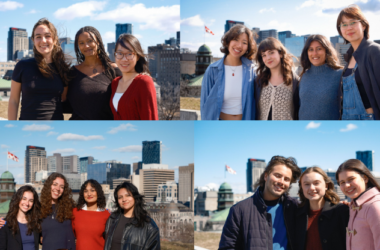CW: Disordered eating
I entered my freshman year at McGill with the dream of becoming a dietitian. After struggling with negative body image and disordered eating during high school, I vowed to dedicate my career to helping those experiencing the same challenges. I also thought that studying nutrition on a scientific level would improve my own relationship with food. I soon realized that while studying nutrition and dietetics comes with benefits and opportunities, there is a dark side to the field.
The classes and environment that I envisioned myself thriving in soon led to an overexposure to information about food and exercise, ultimately causing more harm than good. I constantly questioned my ideas and perceptions about food, weight, and even what the ideal of health looked like.
Growing up in a Chinese-Taiwanese household, my diet consisted of all kinds of food, from white rice, to red meat, to colourful vegetables. However, as I began my classes in nutrition at McGill, I was taught to consult educational resources like MyPlate, which recommends meals with salmon, brown rice, and steamed vegetables, but not the beef noodle soup and scallion pancakes I grew up enjoying. I started internalizing the idea that anything that was not chicken, steamed broccoli, or whole grain was ‘bad’ for me, and I felt guilty for not eating the foods that I was “supposed” to.
Given the hyper-scrutiny I internalized from diet culture and my nutrition education, I pressured myself to eat healthy all the time. As a nutrition student, I believed I had to look and act a certain way in order to be taken seriously, and feared that I could not become a dietician if I did not appear slim and fit. This led to a vicious cycle of food restriction and binging, which made me feel even more ashamed. I wondered how I was supposed to give nutritional advice to others when I was struggling with these issues myself.
Further, telling others that I study nutrition prompted them to scrutinize my dietary choices. The pressure from the expectations of my family, my peers, and even strangers significantly impacted my eating patterns.
Although some of the pressure I felt was self-imposed, much of it also came from external factors. On social media, I noticed how body-shaming insults were hurled at dietitians who were not skinny. The public assumes that nutritionists and dietitians represent the perfect picture of health, without realizing that “health” comes in many different shapes and sizes.
“There is definitely an image associated with the success of a health practitioner, and that image is thin,” Hayley Mauricio, U3 Science, said in an interview with The McGill Tribune. “This expectation further bleeds into social media. There is a world of health and fitness gurus that we look up to because they look good. But of course, social media is not representative of real life.”
Throughout my undergraduate studies, I have internalized many of my struggles, believing that I had to be the person with the answers, not the problems. To my surprise, I eventually learned that I was not alone with these feelings. Eating disorders are of concern in nutrition faculties around the globe: A study in 14 countries revealed that 77 per cent of nutrition professionals, including professors, teachers, and dietitians, felt that developing eating disorders are a concern for nutrition students. A 2015 study echoed these findings, reporting that female nutrition students experienced higher eating restraints and binge eating levels compared to non-nutrition students.
Although these findings are not always consistent, there is a body of evidence to suggest that dietitians and nutritionists throughout the world may be at greater risk for disordered eating behaviour, binge eating, and orthorexia nervosa when compared to other professionals.
Among the public, there is a stigma that nutrition practitioners should be free from food-related issues, such as orthorexia, by virtue of their training and expertise. Truthfully, we all harbour some expectations for professionals in any field of work: Many people would not trust a doctor who smokes. However, these expectations put an enormous amount of stress on students and professionals to look and act a certain way, without realizing that doing so can induce devastating health outcomes.
“I felt that I had to eat healthier to gain some credibility,” Michelle Hsieh, U3 Nutrition, said in an interview with the Tribune. “I remember people coming up to me and saying, ‘Wow, you’re in nutrition and you still eat so much junk food?’ This kind of pressure to always eat clean is not only damaging, it is also not right.”
Although nutrition is a science, food is personal––healthy eating is certainly not one-size-fits-all. One obvious solution to having a more inclusive approach to health is encouraging better representation among leaders in the field.
“The health and wellness industry has, since its inception, perpetuated the image of a white, thin, cisgender, and affluent woman,” Tarini Gupta, U3 Nutrition, said in an interview with the Tribune. “Needless to say, this image is extremely harmful, especially to young, impressionable girls, and needs to be changed.”
For several years, racialized individuals have been underrepresented in the fields of nutrition and dietetics, particularly in leadership ranks. According to the Commission on Dietetic Registration, over 70 per cent of dietitians in the U.S. are white. Although Canada lacks substantial race-based data in this field, the results from a 2018 study highlight the need for the Canadian dietetics field to address systemic barriers that prevent ethnic minorities from becoming registered dietitians. These barriers exclude many individuals who do not identify with the Western-centric narrative of health, as seen by a lack of diverse food choices within the Canadian Food Guide.
“I was not able to resonate with the tools and resources I was taught in class, such as the Canadian Food Guide,” Gupta said. “I grew up eating traditional Indian cuisine. While studying nutrition, I realized that my meals did not look like the ones illustrated in this guide, which made me feel like I was not eating correctly. Though the Canadian Food Guide has made efforts towards inclusivity […], it is still limited in terms of ethnic food accessibility, financial barriers, and an in-depth knowledge of non-Westernized eating patterns.”
As I continue my studies, I have realized the need for conversations surrounding culinary diversity, representation, and eating disorders in the nutrition field. To properly serve Canadians of all backgrounds, our training must reflect the diverse society we currently live in.
The current disparity in nutrition promotes a narrow definition of health, one that is unrealistic and damaging to both the patient and the provider. By dismantling systemic barriers and training experts in the field to understand diverse backgrounds, we can begin to shift conversations surrounding health without sacrificing one’s culture and traditions or subjecting them to food guilt.
For those struggling with disordered eating or an eating disorder, services such as the National Eating Disorders Association Helpline or SSMU’s Eating Disorder Resource & Support Centre may be able to help.









